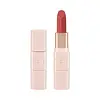What's inside
What's inside
 Key Ingredients
Key Ingredients

 Benefits
Benefits

 Concerns
Concerns

 Ingredients Side-by-side
Ingredients Side-by-side

Isononyl Isononanoate
EmollientNeopentyl Glycol Diethylhexanoate
EmollientDimethicone
EmollientCI 77891
Cosmetic ColorantCI 19140
Cosmetic ColorantAluminum Starch Octenylsuccinate
AbsorbentCopernicia Cerifera Wax
Dimethicone/Vinyl Dimethicone Crosspolymer
Skin ConditioningCI 15850
Cosmetic ColorantSynthetic Beeswax
Emulsion StabilisingLauroyl Lysine
Skin ConditioningSqualane
EmollientSynthetic Wax
AbrasiveDicalcium Phosphate
AbrasiveEuphorbia Cerifera Wax
Ricinus Communis Seed Oil
MaskingCellulose
AbsorbentCI 42090
Cosmetic ColorantParfum
MaskingSodium Hyaluronate
HumectantCI 77491
Cosmetic ColorantPentaerythrityl Tetra-Di-T-Butyl Hydroxyhydrocinnamate
AntioxidantHydrogenated Castor Oil
EmollientPolyhydroxystearic Acid
EmulsifyingIsononyl Isononanoate, Neopentyl Glycol Diethylhexanoate, Dimethicone, CI 77891, CI 19140, Aluminum Starch Octenylsuccinate, Copernicia Cerifera Wax, Dimethicone/Vinyl Dimethicone Crosspolymer, CI 15850, Synthetic Beeswax, Lauroyl Lysine, Squalane, Synthetic Wax, Dicalcium Phosphate, Euphorbia Cerifera Wax, Ricinus Communis Seed Oil, Cellulose, CI 42090, Parfum, Sodium Hyaluronate, CI 77491, Pentaerythrityl Tetra-Di-T-Butyl Hydroxyhydrocinnamate, Hydrogenated Castor Oil, Polyhydroxystearic Acid
Dimethicone
EmollientSynthetic Wax
AbrasiveDimethicone Crosspolymer
Emulsion StabilisingDiphenyl Dimethicone
EmollientBrassica Campestris Seed Oil
Skin ConditioningDicalcium Phosphate
AbrasiveTabebuia Impetiginosa Bark Extract
Skin ConditioningPolyglyceryl-3 Diisostearate
EmulsifyingEthyl Vanillin
MaskingDisteardimonium Hectorite
StabilisingTrimethylsiloxyphenyl Dimethicone
CI 77891
Cosmetic ColorantIron Oxides
CI 15850
Cosmetic ColorantCI 45410
Cosmetic ColorantCI 19140
Cosmetic ColorantCI 42090
Cosmetic ColorantDimethicone, Synthetic Wax, Dimethicone Crosspolymer, Diphenyl Dimethicone, Brassica Campestris Seed Oil, Dicalcium Phosphate, Tabebuia Impetiginosa Bark Extract, Polyglyceryl-3 Diisostearate, Ethyl Vanillin, Disteardimonium Hectorite, Trimethylsiloxyphenyl Dimethicone, CI 77891, Iron Oxides, CI 15850, CI 45410, CI 19140, CI 42090
Ingredients Explained
These ingredients are found in both products.
Ingredients higher up in an ingredient list are typically present in a larger amount.
Ci 15850 is the pigment color red. It is an azo dye and created synthetically.
Azo dyes need to be thoroughly purified before use. This allows them to be more stable and longer-lasting.
This ingredient is common in foundations, lipsticks, and blushes. This color is described as brown/orangey red.
It has many secondary names such as Red 6 and Red 7. According to a manufacturer, Red 6 usually contains aluminum.
Learn more about CI 15850CI 19140 is also known as Tartrazine. Tartrazine is a synthetic dye used in cosmetics, foods, and medicine to add a yellow color.
Tartrazine is created from petroleum and is water-soluble.
Some people may experience allergies from this dye, especially asthmatics and those with an aspirin intolerance.
Learn more about CI 19140Ci 42090 is a synthetic dye created from petroleum. It is used to give a bright blue color to cosmetics, medicine, and food.
Ci 77891 is a white pigment from Titanium dioxide. It is naturally found in minerals such as rutile and ilmenite.
It's main function is to add a white color to cosmetics. It can also be mixed with other colors to create different shades.
Ci 77891 is commonly found in sunscreens due to its ability to block UV rays.
Learn more about CI 77891Dicalcium Phosphate is an exfoliant.
Dimethicone is a type of synthetic silicone created from natural materials such as quartz.
What it does:
Dimethicone comes in different viscosities:
Depending on the viscosity, dimethicone has different properties.
Ingredients lists don't always show which type is used, so we recommend reaching out to the brand if you have questions about the viscosity.
This ingredient is unlikely to cause irritation because it does not get absorbed into skin. However, people with silicone allergies should be careful about using this ingredient.
Note: Dimethicone may contribute to pilling. This is because it is not oil or water soluble, so pilling may occur when layered with products. When mixed with heavy oils in a formula, the outcome is also quite greasy.
Learn more about DimethiconeSynthetic Wax is created from fossil fuels such as natural gas. It is used to enhance texture, adjust pH, and as an occlusive.
It may also be used as an abrasive ingredient to exfoliate the skin.
Synthetic Wax may not be fungal acne safe.
Learn more about Synthetic Wax